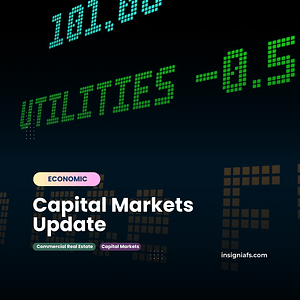CRE Market Update
The commercial real estate (CRE) market is undergoing significant changes in 2023. This article will explore key trends and insights in the lending, retail, multifamily, and industrial sectors. Key takeaways include:
Lending momentum has declined significantly year-over-year, with bridge financing dominating the pipeline.
Private capital is attracted to the CRE market, seeking higher yields.
Credit unions are filling the void left by banks in the retail sector, offering financing with competitive interest rates and terms.
Agency financing remains the preferred choice for multifamily and industrial properties, despite potentially higher interest rates and lower loan proceeds.
The rising 10-year Treasury yield could lead to higher interest rates for CRE borrowers.
Overall Market Trends
Lending Momentum: Commercial real estate lending momentum declined 5% quarter-over-quarter (QoQ) in Q2, reflecting a substantial 52% year-over-year (YOY) decrease.
Agency Allocations: Government-sponsored entities (GSEs) Freddie Mac and Fannie Mae are currently operating at less than 75% of their allocated $75 billion each, prioritizing profit over volume in a departure from previous cycles.
Liquidity and High Rates: The current market stressors are primarily driven by liquidity constraints and high interest rates rather than deterioration in cash flow.
Bridge Financing Dominates: Approximately 75% of the CRE pipeline consists of bridge-to-bridge or bridge refinance requests, reflecting the challenge of meeting capital calls due to the limited supply of limited partner (LP) equity. Factors such as taxes, insurance costs, and capitalization rates are affecting short-term deals that originated in 2021, even when business plans are executed successfully.
Private Capital Attraction: Institutional investors are showing strong interest in private capital, seeking higher yields. Bridge rates for high-quality projects are at 8.5% or more, while middle-market deals command rates exceeding 10%. In some cases, investors are providing small equity checks, sometimes taking a share of the coupon and general partner (GP) share.
Retail Sector
Credit Unions Fill the Void: Credit unions have stepped in to fill the void left by banks, which now require a deposit relationship of over $1 million for liquidity. Credit unions face fewer balance sheet liquidity issues and offer prime-based lending with interest rates starting at 8.5% or higher and a 25-year amortization period in secondary and tertiary markets. Major markets will see 5-year deals with spreads ranging from approximately 200 to 220 basis points (around 7-7.25%) and a 30-year amortization period.
CMBS Takes the Lead: Commercial Mortgage-Backed Securities (CMBS) are the preferred option for non-recourse financing, often featuring interest-only payments and sizing up to 1.25 times the property’s income. However, a drawback is the standard 10-year term with a spread of around 200 basis points, although this is offset by the availability of a new 5-year product with a spread of about 250 basis points.
Life Insurance Companies Offer Tighter Spreads: Life Insurance Companies offer a robust financing option with tighter spreads ranging from 150 to 200 basis points and a 1.25 times or higher amortization rate.
Multifamily and Industrial Sectors
Agency Financing Remains Preferred: Agency financing remains the preferred choice in the multifamily and industrial real estate sectors despite potentially higher interest rates and lower loan proceeds. This preference is due to the predictability of execution and the ability to bridge the leverage gap with preferred equity (up to 75% Loan-to-Value at rates ranging from 12% to 15%, with accrual structures available). A recent trend involves buying down interest rates, a strategy commonly employed for all securitized loans, whether Agency or CMBS. By paying a 1% fee, borrowers can reduce spreads by 25 basis points, with buydown options of up to 2% available and occasionally 3% for CMBS loans. This approach ultimately helps lower rates, improve Debt Coverage Ratios (DCR), enhance cash flow, and increase net proceeds.
Agency and CMBS Spreads Similar: Agency spreads typically range from 175 basis points to as high as 245 with prepayment flexibility, while CMBS spreads are in a similar range (180 basis points to 245) but typically come with no prepayment option and feature a 5-year term.
Life Insurance Companies Gain Market Share: Life Insurance Companies have been gaining a substantial market share in the industrial sector, primarily due to their prepayment flexibility and competitive spreads, with CMBS being a secondary choice primarily driven by leverage considerations.
Looking Ahead:
Rising Treasury Yields: The 10-year Treasury yield recently surpassed the 4.35% resistance point, raising the likelihood of reaching 5% before dipping below 4% by the end of the year.
Decreased Probability of Rate Hikes: Forward yield curves suggest a decreased probability of the Federal Reserve raising rates again in 2024, thanks in part to U.S. Treasuries doing much of the heavy lifting.
No Expectations for Rate Cuts Until September 2024: There are no expectations for rate cuts until September 2024 at this time.
Volatile U.S. Treasuries: U.S. Treasuries are expected to remain volatile until the Treasury completes its campaign of auctions to replenish the deficit incurred by COVID-19 stimulus measures.



